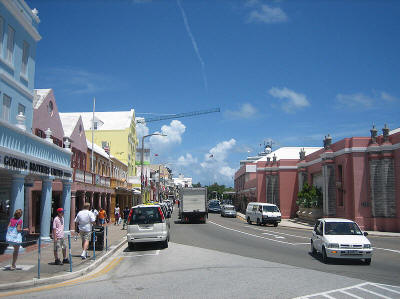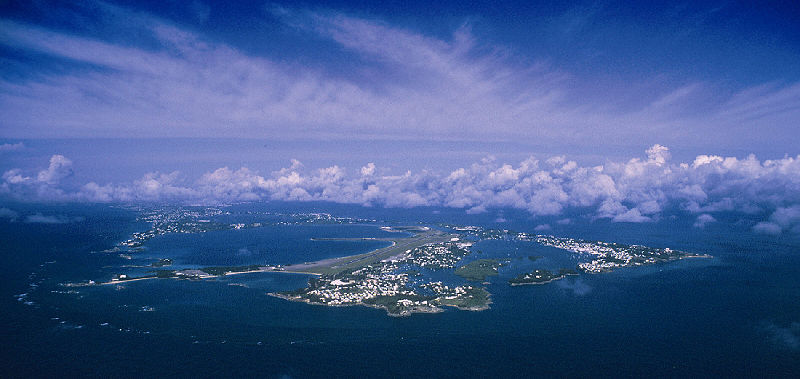|
People |
| Economy, Government, and People
The colony's economic mainstays are international financial services, especially insurance and reinsurance, and tourism. Fine beaches, an excellent climate, and picturesque sites have made Bermuda a fashionable and popular year-round resort. Semitropical produce, sales of fuel to aircraft and ships, and the reexport of pharmaceuticals also contribute to the economy. Most capital equipment and food is imported. Bermuda is divided into nine parishes and two municipalities. The British monarch, represented by a governor, is titular head of state. Bermuda is led by a premier and has a bicameral parliament with an appointed 11-member Senate and an elected 36-member House of Assembly. About 55% of Bermuda's inhabitants are of African ancestry, descended from slaves brought to the islands during the 18th cent.; there is also a sizable population of British descent. English is spoken. The main religions are the Anglican, Roman Catholic, African Methodist Episcopal, and other Christian churches. |

|
Bermuda Coat of Arms |
Bermuda Coat of Arms
 Awarded by Royal Warrant at the Court of St. James, London, on October
4, 1910. Commissioned by the Bermuda Government from London's College of
Arms for Bermuda's tercentenary in 1909.
Awarded by Royal Warrant at the Court of St. James, London, on October
4, 1910. Commissioned by the Bermuda Government from London's College of
Arms for Bermuda's tercentenary in 1909.
It is a white and blue shield with a red lion holding a scrolled shield showing the sinking of Admiral Somer's flagship Sea Venture off Bermuda in 1609.
Armorial Ensigns are Argent on a Mount Vert a lion sejant affrontee Gules supporting between the forepaws an Antique Shield Azure, thereon a representation of the wreck of the Ship 'The Sea Venture' (AD1609) all proper, together with the motto Quo Fata Ferunt.
This is from Virgil's Aeneid and its translation from the Latin is Whither the Fates do Lead Us.
|
Geography |

One of the nine smallest places in the world, in total land area. 21 square miles or 53 square kilometers, compared to the USA's 9.629 million square kilometers.
The whole of Bermuda is tiny by world standards - with a land area of only 21 square miles or 56 square kilometers. It includes all the islands mentioned above. Residents and visitors can travel from one end to the other in just over an hour and from north to south in 10 to 15 minutes. Scientific theory has it that what we know today as Bermuda began some 100 million year ago as a volcanic mountain, with the volcanoes having disappeared 70 million or so years ago.
Some oceanographers say the Bermuda Rise juts up from the deep Atlantic Ocean floor in the form of three steep- sided mountains, the largest of which supports the Bermuda Islands we know today, on the southern margin of a shallow water platform, with Challenger and Argus (or Plantagenet) Banks to the southwest. Others say the Bermuda Rise is five mountains including the more distant Bowditch and Muir Seamounts (the furthest of which is about 150 miles to the northeast).
The Bermuda Mountain is longer - 32 miles - than the land area width and much wider - 16 miles wide - than the maximum land width of 1.5 miles. At sea, the Argus and Challenger Banks are round and about 6 miles across.
Below the level of limestone and 450 feet below sea level is volcanic rock; and below that, only black lava and other igneous volcanic rock. Only in one place in Bermuda - 60 feet below sea level at the southern end of Bermuda International Airport -is volcanic rock found so near to sea level.
The other name - the Somers Isles - commemorate Bermuda's British founder father, discoverer in 1609 and colonizer, Admiral Sir George Somers, when it was not populated at all. In 1612 the Bermudas, then the Somers Islands, were in the third charter of the Virginia Company. More English colonists arrived specifically for Bermuda. The charter was revoked in 1684 when Bermuda became a British crown colony. However, it was once referred to as Virgineola, in its 16th century brief period as a dependency of Virginia.
Today, Bermuda remains a (nominal) British possession, a completely self-governing British Overseas Territory, with its own laws - not those of the United Kingdom. No UK laws apply in Bermuda and Britons are just as much foreigners as are Americans, Canadians, Europeans, Asians and other citizens.